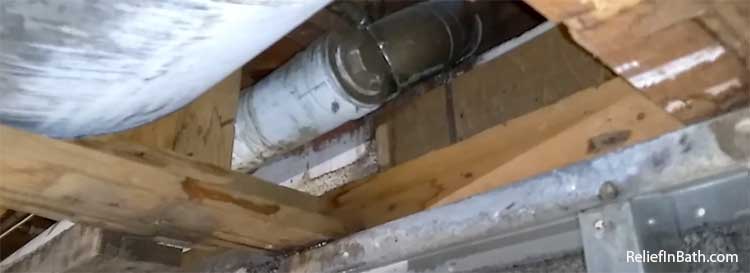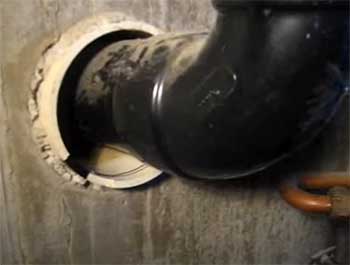A septic system is the most commonly used alternative to sewer systems. If your house is not connected to a city-wide sewer system, chances are it uses a septic system to get rid of sewage waste.
A common issue with septic systems is pipe leakage. If you suspect your basement or somewhere else has a leak and you want to know what caused it and how to fix it, then read on.
Signs of a Leaked Septic Pipe In The Basement

The pipes leading into your septic tank run throughout your house. The wastewater from toilets, dishwashers, washing machines, and other places runs through an inlet pipe into your septic tank.
Even if you do not know the exact location of the leak, there are a few common signs that are usually indicative of a pipe leak. Let’s look at a few of them.
- Foul Odor
This is likely the first sign you will notice in the case of a leaky pipe. The smells of the sewage and wastewater running through the leaky pipe seep into your house.
If you smell the musty odor of raw sewage somewhere in your house, chances are you have a leaky pipe.
- Visible Mold
If you find any visible mold or algae growing inside your house, that was likely caused by a leaky pipe.
Surfaces such as wood or concrete become damp because of the sewage leaking into them, causing mold to grow.
- Pooled Water
In some cases, you may find that dirty-looking water has pooled in a specific location without cause.
If you discover this, especially in a place without direct contact with water sources, it is likely a pipe leak.
- Surface Damage
This usually starts with wet spots and stains on floors, ceilings, or walls. You may not think much of it at first, but if not swiftly dealt with, it can cause significant damage.
It starts off as a barely noticeable stain on a surface. Eventually, it will start to damage it, even causing it to crack at some point and release sewage into your house.
Causes of Septic Pipe Leakage

If you find one or more of the signs in and around your house, you can safely assume you have a pipe leak somewhere.
Now, let’s see some of the reasons and causes behind the leaky pipe.
- Clogged Pipes
Clogged pipes are some of the most common causes of leaky pipes. Pipes are built to help the flow of liquid into a specific place.
So, if any kind of solid passes through, it can potentially block the normal flow of liquid. This blockage leads to excessive pressure on the pipes, causing them to possibly crack and leak.
- Damaged Seals
Appliances such as washing machines and dishwashers are connected to pipes with rubber sealants.
However, over time, this seal can weaken and eventually break. This can cause leaks near the connecting area.
- Pipe Corrosion
Over time, as your septic system ages, corrosion such as rust can damage your pipes. This is especially true in the case of older houses. Even bad laundry detergent can damage the septic systems!
At a certain point, all the damage adds up and creates openings in the pipe, causing sewage and wastewater to leak.
- Bad Septic System
The pipes in your septic system should always be laid by trained professionals. Oftentimes, the cause of a leak is not some visible damage but incorrect pipe laying.
It is important that the pipes are laid well enough so that the water can flow smoothly. If you suspect that your septic system has improperly laid pipes, contact a professional to fix it.
- Damaged Pipe Joints
In any kind of plumbing system, the joint areas are some of the most vulnerable places.
Over time, the joints can get damaged by different causes. This can eventually lead to the joints weakening and causing leakage.
Dangers of Sewage Leaks in the Basement
Beyond just the mess and headache, sewage flooding your basement poses some serious health and safety hazards that shouldn’t be ignored:
- Raw Sewage Exposure
Raw sewage contains dangerous bacteria, viruses, parasites, and toxins. Exposure can lead to severe infections or serious gastrointestinal illness.
- Mold Growth
Sewage water flooding will quickly feed mold growth on any porous surfaces like drywall, insulation, carpeting, wood, and fabrics. Certain molds release toxic spores that can cause respiratory issues.
- Electrical Damage
If leaking pipes run near electrical systems, it can create electrocution and fire risks. Water conducts electricity and can easily damage wiring and electrical components.
- Structural Impacts
Pooling water weakens foundations, warps walls and framing, degrades cement, and rots wood over time. If left unaddressed, leaks can undermine the structural integrity of the entire home.
Dealing with a sewer leak promptly reduces health dangers and prevents permanent damage to the basement and home.
Solutions To A Leak
At this point in the article, you should now know the signs of a pipe leak and what causes it.
Now, before you do anything, call a professional! However, let’s look at all the possible fixes and solutions to leakage a professional plumber will usually take:
- Shut Down the Flow of Water
In the case that the pipe leakage is extreme and water is going everywhere, a temporary fix is to shut off the water supply.
This will give you enough time to clean up the area while you wait for a professional to arrive and permanently fix the leak.
- Applying Tape Over the Leak
Many different types of tape can be solid options for containing minor leaks. Tapes such as duct tape, teflon tape, and electrical tape can work well, depending on the pipe.
Before you apply the tape, you must first dry the area as much as you can so the tape can adhere properly.
After that’s done, the tape is applied completely flat against the pipe so that no water can fill up inside the tape.
- Clamp the Pipe With a Pipe Clamp
A pipe clamp is made of metal sleeves with a rubber interior. All you have to do is, purchase a pipe clamp that is the same size as the leaking pipe.
Then, place the rubber over the leaking area. Then, after it has been positioned properly, close the clamp around the pipe.
- Applying Epoxy Compounds Over the Leak
Epoxy compounds such as J-B Weld and Quiksteel can be found in most hardware stores.
After you have purchased one, mix it until it turns into a light grey putty. Then, wrap the putty around the leak and allow it to set for five to ten minutes.
- Pipe Patching and Sealing
For small cracks and pinhole leaks in pipes, applying epoxy-based sealants or clamps can effectively patch the damage. Thoroughly clean and dry pipes first for the best seal.
- Pipe Replacement
If pipes are badly corroded or have developed major cracks, replacement may be necessary. This involves cutting out the damaged sections and splicing in new piping.
- Resealing Pipe Joints
Loose joints that have separated just need to be sealed again with fresh plumber’s putty or rubber gaskets. Ensure joints are completely dry first.
- Trenchless Pipe Lining
For extensive pipe damage, trenchless lining is a minimally invasive option. Flexible epoxy resin coatings are inserted via the sewer main to seal cracks and reinforce pipes.
- Foundation Repairs
If leaks are entering through foundation cracks, sealants, injection foams, or drainage systems can be added to direct water away from problem areas.
- Call a Professional
The last and only permanent solution to a leaky pipe. After you have managed to contain the leak using one of the aforementioned solutions, you should then call the proper professionals.
They can properly assess the situation and then come up with a permanent solution to your leakage. But before you call a professional, watch this video.
Preventing Future Sewer Leaks
After fixing the immediate sewer leak, it’s equally important to take preventative steps to avoid recurrence in the future:
- Install cleanout plugs to allow easy access for drain cleaning and pipe inspections. Routinely flush pipes.
- Update old piping in the home with newer, durable plastic pipes less prone to cracking.
- Waterproof basement walls and flooring to prevent groundwater seepage.
- Install an overhead sewage ejector pump if any drains sit lower than the main sewer line.
- Remove any trees near exterior sewer lines whose roots could invade and damage pipes.
- Keep heavy objects away from overhead pipes in basement ceilings.
- Have a professional plumber inspect and pressure test pipes annually.
With proactive maintenance and repairs as needed, you can keep your basement sewer system leak-free for the long run.
Frequently Asked Questions (FAQ)
Below are some frequently asked questions and their answers.
If you discover a leaky pipe in your basement, you should first try to contain the leak as much as you can. Afterward, call a professional to fix it.
You can temporarily seal leaky pipes in your basement using different tapes or epoxy compounds.
If you smell raw sewage around your house and see dirty water pooling, you probably have a leaky pipe.
Leaks are caused by clogged pipes, corrosion, improper pipe laying, and more.
Start by thoroughly tracing the leaking pipe to find the exact source, whether it’s a cracked section, separated joint, or hole. For small leaks, apply epoxy sealants or clamps. Larger leaks may require replacing portions of pipe or having them lined and sealed internally with epoxy resin.
Act quickly to stop the source and limit water damage. Contain any sewage that has leaked with towels and rags. Run fans and dehumidifiers to dry out the area. Disinfect contaminated surfaces to kill bacteria using bleach solutions or antimicrobial sprays. Call a professional plumber to properly identify and repair the leaky pipe.
Final Thoughts
A leaky pipe may only be a minor nuisance at first. But if it is not fixed, over time the damage can build up and cause significant damage to your house.
So, leakages require prompt action. Hopefully, after reading this article, you now know the proper steps to take if you discover a septic pipe leaking in the basement or anywhere else in your house.
